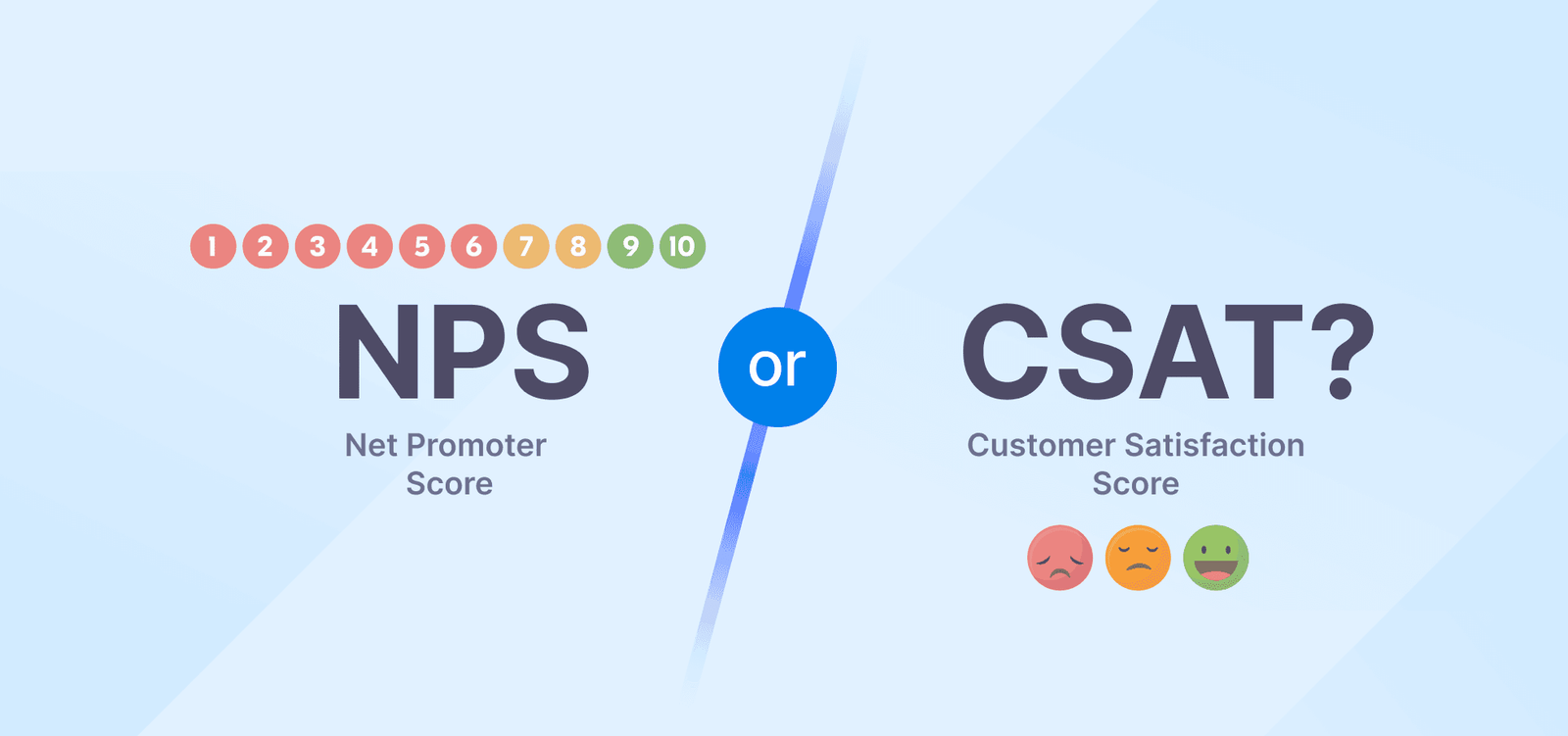Introduction to CSAT and NPS
Customer Satisfaction Score (CSAT) and Net Promoter Score (NPS) are two prominent metrics utilized to gauge customer experience and assess loyalty. Understanding these metrics is essential for businesses aiming to enhance their customer-centric approaches. Both CSAT and NPS yield valuable insights into customer sentiment, yet they cater to different aspects of the customer journey and serve distinct purposes.
CSAT is a straightforward measure of customer satisfaction, typically gathered through surveys immediately following a product purchase or service interaction. Respondents are asked to rate their satisfaction on a scale, often ranging from one to five or one to ten. This metric captures specific feelings toward a product or service, allowing businesses to assess immediate reactions and responsiveness. Consequently, CSAT is particularly useful for identifying areas that require immediate improvement and guiding ongoing product and service enhancements.
On the other hand, the Net Promoter Score (NPS) takes a broader approach by measuring customer loyalty and the likelihood of recommending a brand to others. It utilizes a single-question survey asking customers to rate their willingness to recommend the company to friends or colleagues on a scale from zero to ten. Based on their responses, customers are classified into promoters, passives, or detractors. This classification helps businesses gauge overall brand loyalty and predict future growth. NPS is particularly effective for long-term strategic planning and assessing overall brand performance.
In summary, understanding what is CSAT and NPS? which one is better involves recognizing their unique characteristics and applications. While CSAT focuses on immediate customer satisfaction and specific interactions, NPS provides insights into long-term brand loyalty and advocacy. Businesses can leverage these metrics, along with their insights, to refine customer experience strategies and foster stronger relationships with their clientele.
Strengths and Weaknesses of CSAT
Customer Satisfaction Score (CSAT) is a widely adopted metric in evaluating customer opinions regarding their experiences with a product or service. One of the significant strengths of CSAT is its ability to provide immediate feedback on specific aspects of the customer experience. This feature allows organizations to pinpoint areas requiring improvement and to make quick adjustments, thereby enhancing overall service quality and customer satisfaction. By deploying CSAT surveys right after a transaction or interaction, businesses can gather actionable insights that reflect the customer’s immediate perception of service levels, leading to timely remedial actions.
Furthermore, CSAT is straightforward and easy to understand for both customers and organizations. Respondents typically answer a simple question about their satisfaction level, often using a scale (such as 1 to 5 or 1 to 10), making it accessible for a wide audience. This simplicity encourages a higher response rate, yielding a larger pool of data for analysis, which can provide valuable insights into customer needs and preferences.
However, CSAT is not without its weaknesses. A notable limitation is its inability to gauge long-term customer loyalty and satisfaction, as it primarily captures short-term feelings following specific interactions. Consequently, relying solely on CSAT may lead businesses to overlook deeper issues affecting customer retention. Additionally, CSAT is susceptible to bias based on customers’ most recent experiences; a single negative event can disproportionately affect the overall score. This focus on the present may result in companies ignoring historical trends or recurring issues that impact customer satisfaction over time.
In conclusion, while CSAT offers immediate, actionable insights into customer experiences, its limitations necessitate careful consideration. Evaluating CSAT alongside other metrics, such as Net Promoter Score (NPS), can provide a more comprehensive understanding of customer satisfaction and loyalty. Businesses should strive for a balanced approach when choosing the right metric for their specific needs.
Strengths and Weaknesses of NPS
The Net Promoter Score (NPS) has gained popularity as a key metric for measuring customer loyalty and predicting business growth. One of its primary strengths lies in its simplicity. By asking customers a straightforward question—how likely are you to recommend our product or service to others?—organizations can collect data that provides insights into overall customer satisfaction levels. This ease of implementation makes NPS an appealing choice for businesses that desire a quick assessment of their customer relationship health.
Moreover, NPS can effectively segment customers into promoters, passives, and detractors. This classification allows businesses to understand not only how satisfied their customers are but also who their most loyal advocates are. Research indicates that promoters tend to have a significant positive impact on a company’s growth by driving referrals and repeat purchases. Additionally, organizations can leverage NPS data to identify trends within their consumer base and make informed strategic decisions aimed at improving customer retention.
However, while NPS provides valuable insights, it has notable weaknesses. One primary drawback is its inability to capture the complexities of customer satisfaction fully. Customers may feel satisfied with a product yet still score low on the NPS scale due to various reasons that are not addressed by a single question. Moreover, the focus on promoters can lead companies to overlook the feedback from detractors, who may provide critical information that can help to enhance products or services. Businesses that employ NPS as their sole metric may find themselves with an incomplete understanding of customer needs and sentiments.
In conclusion, while the Net Promoter Score serves as a useful tool for assessing customer loyalty and predicting retention, organizations should consider complementing it with other metrics that can provide deeper insights into customer satisfaction. Exploring alternatives such as Customer Satisfaction Score (CSAT) can lead to a more comprehensive understanding of customer relationships and inform better decision-making.
Which Metric Should You Use? A Decision-Making Framework
Deciding which customer satisfaction metric to adopt—CSAT, NPS, or potentially both—depends on various factors including business goals, customer interactions, and industry characteristics. Each metric serves distinct purposes and offers different insights into customer experiences and loyalty.
CSAT, or Customer Satisfaction Score, primarily measures customer satisfaction with a specific product or service. It is typically simpler and quicker to implement, making it an ideal choice for businesses looking to gather immediate feedback following customer interactions. For instance, businesses in fast-paced environments such as retail or hospitality may find that CSAT is more relevant, as they can swiftly gauge customer sentiment and quickly address areas needing improvement.
In contrast, NPS, or Net Promoter Score, provides a broader perspective on customer loyalty and future behavior. This metric focuses on the likelihood of customers recommending a business to others. Companies aiming for long-term growth and relationship building may prioritize NPS to assess brand loyalty over time. Technology firms, for example, often use NPS to understand customer advocacy and retention, as it helps in identifying promoters who can become brand evangelists.
Combining both metrics can yield a more comprehensive understanding of customer satisfaction and loyalty. While CSAT offers momentary satisfaction insights, NPS provides an overarching view of customer commitment. For instance, a subscription-based service may benefit from both by assessing immediate customer experiences through CSAT, while employing NPS to gauge overall loyalty over the subscription lifecycle.
Ultimately, businesses must choose a metric that aligns with their strategic objectives and customer engagement practices. By carefully evaluating which metric serves their needs best, companies can better navigate customer satisfaction and loyalty, ensuring a more tailored approach to enhancing the customer experience.





